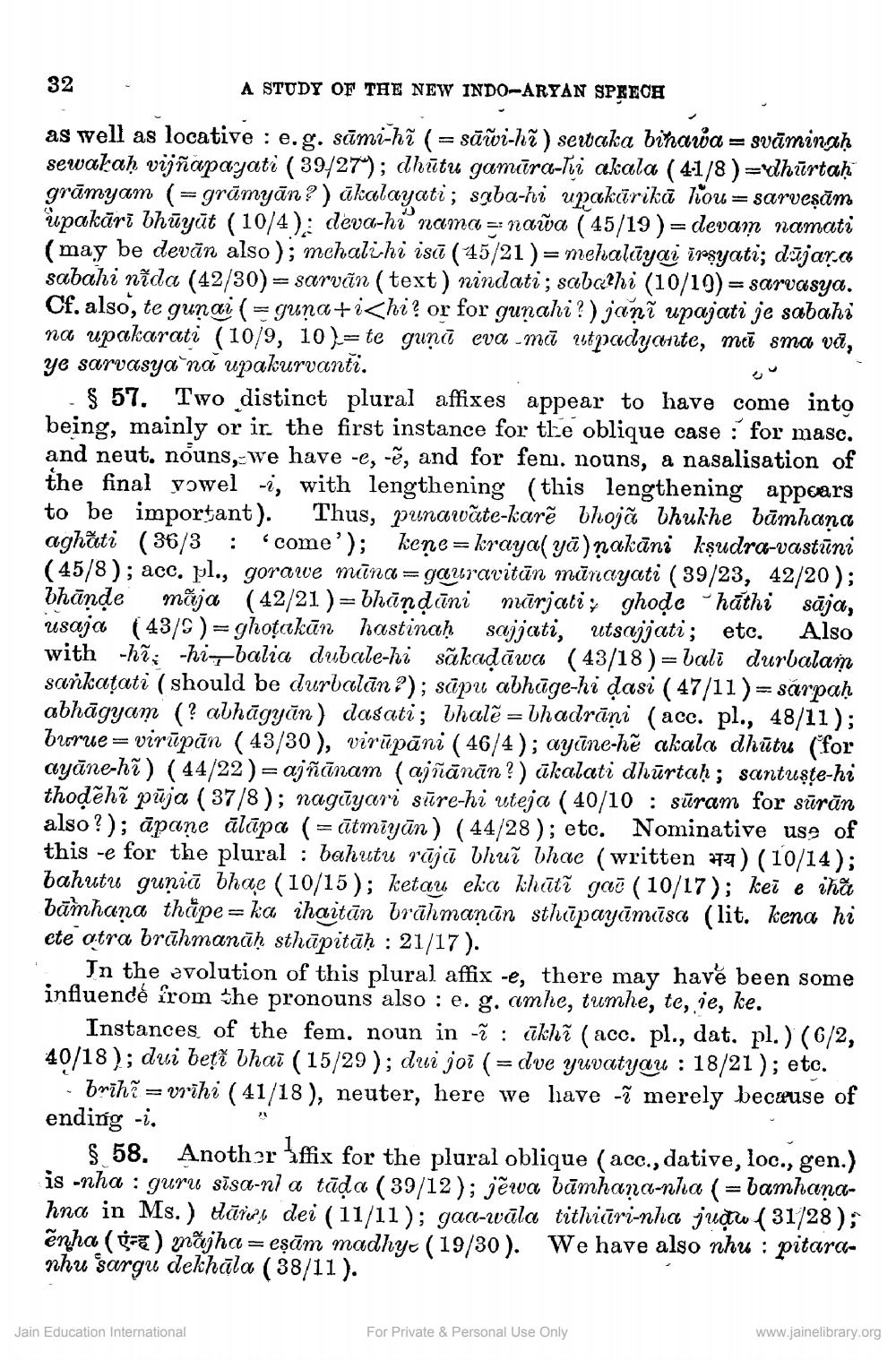________________
32 -
A STUDY OF THE NEW INDO-ARYAN SPRECH as well as locative : e.g. sāmi-hã ( = sāwi-hã) sertaka bihara = svāmingħ sewakaḥ vijñapayati ( 39/274); dhūtu gamūra-Ti akala (4:1/8)=rdhūrtaḥ grāmyam (=grāmyān?) ākalayati; saba-hi upakurikā Tvou = sarveşām upakäri bhūyut (10/4): deva-hi nama =: nawa ( 45/19 )= devam namati (may be devān also ); mchalihi is ( 45/21 )= mehalayai irsyati; dājar.es sabahi nīda (42/30) = sarvan (text) nindati; sabalhi (10/19)= sarvasya. Cf. also, te gunai (=guna+i<hi? or for gunahi?) jaņā upajati je sabahi na upakarati (10/9, 10)= te gunā eva -mc utpadyante, meī sma va, ye sarvasya na upakurvanti.
$ 57. Two distinct plural affixes appear to have come into being, mainly or ir, the first instance for the oblique case : for masc. and neut. nouns, we have -e, -ē, and for fem. nouns, a nasalisation of the final vowel -i, with lengthening (this lengthening appears to be important). Thus, punawāte-karē bhojã bhukhe bāmhana aghāti (36/3 : "come'); keņe=kraya( yā)ņakāni kşudra-vastūni (45/8); acc. pl., gorawe mana = gauravitān mūnayati (39/23, 42/20); bhānde mája (42/21 )=bhāņdāni märjati; ghode "hăthi sāja, usaja (43/9 )= ghotakān hastinaḥ sajjati, utsajjati; etc. Also with hã; -hizbalia dubale-hi sākadāwa (43/18)=bali durbalan sarkațati (should be durbalān?); sāpu abhūge-hi dasi ( 47/11 )= sarpaḥ abhāgyam (? abhāgyān) dasati; Thalệ=bhadrāni (acc. pl., 48/11); burue = virūpān ( 43/30), virūpāni ( 46/4); ayine-hč akala dhūtu (for ayāne-hã) ( 44/22)= ajñānam (ajñānān?) ūkalati dhūrtah; santuște-hi thoděhž pūja ( 37/8); nagŪyari stre-hi uteja ( 40/10 : sūram for sūrān also?); āpane ālāpa ( = ātmīyān ) ( 44/28 ); etc. Nominative use of this -e for the plural : bahutu ruājã thuž vhac (written 7) (10/14); bahutu gunici bhae (10/15); ketau eka khūtī gaë (10/17); kei e chá bāmhana thåpe = ka ihaitān brāhmaṇin sthiīpayāmāsco (lit. kena hi ete otra brāhmanāḥ sthūpitāḥ : 21/17). . In the evolution of this plural affix -e, there may have been some influende from the pronouns also : e. g. amhe, tumhe, te, ie, ke.
Instances of the fem. noun in -: cīkhã (acc. pl., dat. pl.) (6/2, 40/18); dui beţi bhai (15/29 ); dui joi ( = dve yuvatyau : 18/21); etc.
- Brihi = vrihi ( 41/18), neuter, here we have -ī merely because of ending -i.
§ 58. Anothör Affix for the plural oblique (acc., dative, loc., gen.) is -nha : guru sīsa-ni a tāda (39/12); jệwa bāmhana-nha (= bamhanahna in Ms.) dāiet dei (11/11); gaa-wāla tithicīri-nha juğw (31/28); enha (177) májha = eşām madhyc (19/30). We have also nhu : pitaranhu sargu dekhāla (38/11).
Jain Education International
For Private & Personal Use Only
www.jainelibrary.org




